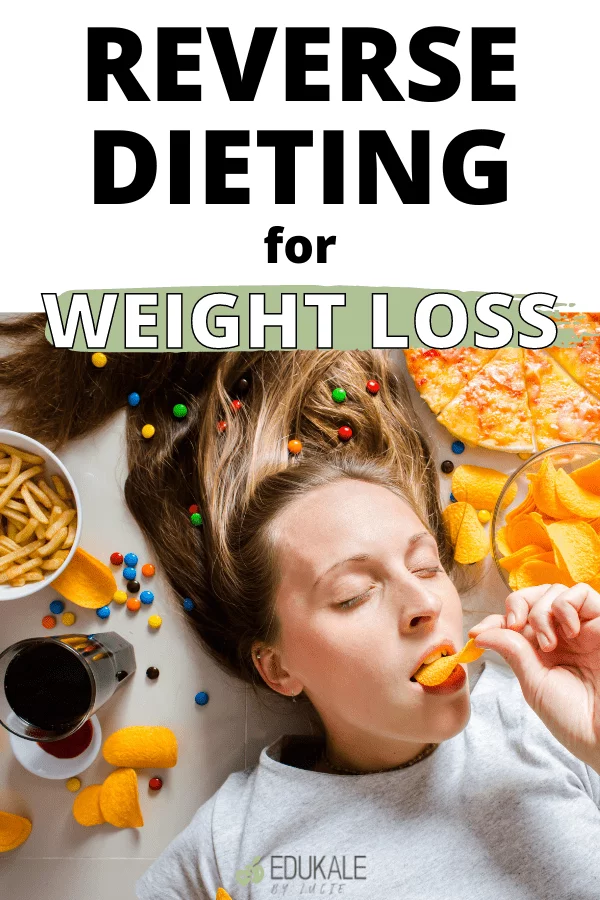This post contains affiliate links from which I may receive a small commission, at no extra cost to you. In no way does this affect my opinion or the information I provide on the product. Please read my disclaimer for more info.
Written by Lucie Villeneuve, nutritionist, M.Sc.
It sounds too good to be true: a diet where you eat more food in order to lose weight. This is the concept of reverse dieting, which is starting to gain some popularity in the mainstream world. Indeed, we are starting to realize that going on drastic diets leads to yoyo-dieting and gaining all the weight back (+ more!) and that it’s time to look for alternate solutions. Could reverse dieting be the answer to our problems?

What is reverse dieting?
Reverse dieting is a way of eating that involves gradually increasing your calorie intake over a few weeks or months. It usually involves increasing your calorie intake by 50-150 calories per week until you reach your target intake. The goal is to raise your metabolism so that you’re able to burn more calories throughout the day. This diet plan is used by people who have been on calorie-restrictive diets in the past and are looking to return to a more normal way of eating without gaining weight.
Does reverse dieting work?
When you go on a diet, you will enter a calorie deficit, meaning that you will burn off more calories than you consume. This will make you use your glycogen and fat storages for energy, leading to weight loss. However, this will slow down your metabolism [1]. This is a normal process: since you’re going to be losing weight, you’re going to be requiring less energy to keep it functioning properly. This will cause you to burn less calories at your resting state.
This makes it very difficult to maintain weight loss as you need to be eating less and less the more your metabolism slows down— this is where reverse dieting comes in.

The idea is that, by gradually increasing your calorie intake, you will boost your metabolism and normalize your hunger hormones, which will encourage weight loss. Indeed, leptin, the “satiety hormone”, decreases when you calorie restrict and lose weight [2, 3].
In addition, dieting increases your ghrelin levels, which is the hormone that stimulates hunger [4]. Gradually increasing the number of calories you consume will counteract these effects and help normalize these hormone levels. Your appetite will slowly decrease and your fullness signals increase, contributing to weight loss.
Reverse dieting could also increase your NEAT, or non-exercise activity thermogenesis. Your NEAT includes all the daily living activities you do other than physical exercise, like pacing, standing, fidgeting… [5].
When you calorie-restrict and lose weight, you have less available energy to expend, so your NEAT is likely to decrease [6]. Eating more calories through reverse dieting may help counteract that.
Another potential benefit of reverse dieting is reducing the frequency of binge eating episodes. When you diet and restrict what you eat, you’re probably not getting the necessary nutrients for your body, or at least not satisfying your cravings. After a while, your body desperately wants energy and craves the “off-limits” foods, so you find yourself binge-eating anything you can get your hands on. This obviously isn’t healthy and leads to weight gain. By increasing your calorie intake gradually, you’re going to be able to eat more foods that make you feel good (both physically and emotionally!) which could help reduce binge eating.

Check out my article on how to stop binge eating for more information!
All of these reasons certainly seem promising, but it’s important to note that reverse dieting has not been the subject of many studies. To this day, very little research supports reverse dieting, and while there are success stories, they are anecdotal.
It also concerns people who have been restricting or have gone on diets in the past. If you currently eat over 3000 calories of mainly junk food and decide to increase your intake gradually to lose weight, it will not work. I’ll discuss alternative solutions to reverse dieting in a little bit.
How to start reverse dieting.
If you feel like reversed dieting could be right for you, here are some steps to get started.
First of all, you need to know your daily maintenance calories, which is the current amount of calories you need to maintain your weight. If you need help figuring that out, you can check out this tool from Precision Nutrition. Once you have that number, you can add around 5% more calories to it each week. This means that if you currently eat 1500 calories to maintain your weight, you should go up to 1575 on week one, 1654 on week two, and so on. Some people prefer to start by adding 50 calories a day for a week, then 50 more the following week, and so on. It’s up to you. Most of these extra calories should be nutrient dense foods. A balanced mix of protein and fiber is ideal. Some fruit with nut butter, veggies with hummus, an extra helping of beans…

It’s a good idea to weigh yourself weekly throughout this process to monitor the reverse diet. If you’re gaining more than a pound a week, you may be increasing calories too quickly and should bring them back down a little. If you’re losing weight, you can increase them a little.
Keep in mind that some weight fluctuation is normal in the beginning as your body readapts to eating more food.
Little by little, you can work your way up to eating your target amount of calories, and stabilize there.
The downsides of reverse dieting and what to do instead.
While I do like the idea behind reverse dieting, I definitely think it has a few downsides, aside from not being a well-researched eating plan.
First of all, it implies strict calorie tracking, because you need to be able to know exactly how much you’re eating in order to add the 50-150 extra calories daily. This may not be an issue for some people, but if you aren’t used to calories and portion sizes, you may find it hard to be precise with the extra calories.

This also implies weighing yourself to monitor the diet and to adjust it if needed. While this isn’t a problem in itself, it can be triggering for people who are trying to move away from dieting and restriction.
Reverse dieting is different than going all in, which is another approach used by people who want to go back to eating more normally after a dieting period. Going all in implies eating whatever foods you want, whenever you want, and until you are completely satisfied. Reverse dieting is still a controlled approach to eating and weight, so it probably isn’t ideal for people trying to find food freedom and looking to free themselves from diet culture.
So what should you do instead?
As usual, I like to promote a middle ground approach: eating a variety of whole, healthy foods and having delicious yet balanced meals. While some foods are healthier than others and should make up most of your meals (fruit and veggies, whole grains, healthy protein, nuts and seeds…), there’s room for ANY food you like and nothing has to be off-limits.
Any restrictive dieting should be avoided, and you must be in it for the long haul. This is why I recommend intuitive eating, which is very sustainable.
Beyond healthy eating, it’s crucial to maintain a healthy relationship with food, to get into the correct mindset for healthy eating, to be physically active, and to take care of your mental health. Don’t hesitate to read my article on healthy eating for beginners to get you started.
If you feel like you need help that is specifically tailored to your needs, I also offer one-on-one online coaching so we can reach your goals together! You can read more about that here.
Reverse dieting in conclusion.
Reverse dieting is a way of eating that involves gradually increasing your calorie intake until reaching your target intake, thus slowly increasing your metabolism. After a calorie-restrictive diet, it can be a way to return to a more normal way of eating without gaining weight. However, reverse dieting is still a controlled approach to eating and requires strict calorie counting and tracking, so it isn’t for everyone!
-Lucie
If you’re interested in nutrition, its impact on our health, and the science behind it, you should definitely read How Not to Die. In this book, Doctor Michael Greger, founder of Nutrition Facts, examines the top causes of death in America and explains how your diet can prevent— and in some cases even reverse— them. His advice is all backed by science and he writes in a very clear and entertaining way. This book isn’t a list of what you already know. It will teach you the keys to living a long healthy life, in a simple and practical way, and without spending fortunes on supplements and pills!
PLUS if you want to take it a step further, you can check out the How Not to Die Cookbook to implement the advice easily!


